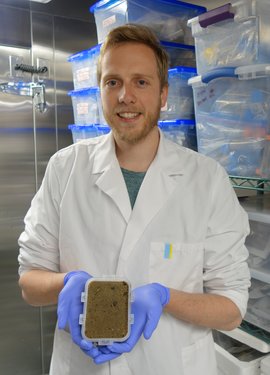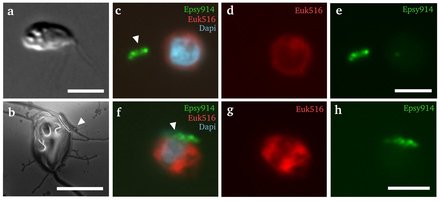Page path:
- Press Office
- How bacteria learn to love their foes
How bacteria learn to love their foes
Jun 1, 2016
Time-travel with microbes
If you want to know how our prehistoric ancestors looked like, you might take a glimpse through the microscope. If you are lucky you’ll find them: tiny, unicellular eukaryotes - also called protists. Protists are direct relatives of animals, plants and fungi. However, these single-celled organisms have hardly changed their appearance in the course of evolution. Many of them still do exactly what their ancestors have been doing for ages: They hunt and eat other microorganisms. One such a group of predatory protists are the so called Breviatea. This group appeared about a billion years ago - at a time when oxygen was scarce in the deep ocean.
As an adaptation to oxygen depletion, Breviates use a rather simple metabolism: fermentation. This process yields significantly less energy than, for example, bacterial nitrate respiration. Facing this situation, wouldn’t it be handy for the Breviates to cooperate with bacteria to increase the efficiency of their metabolism? Sounds logical. But there is one problem: Bacteria are the favorite prey of Breviates.
An international research group led by Emmo Hamann, Harald Gruber-Vodicka and Marc Strous still wanted to know if such partnerships are possible - and provides exciting insights that have now been published in the journal Nature.
If you want to know how our prehistoric ancestors looked like, you might take a glimpse through the microscope. If you are lucky you’ll find them: tiny, unicellular eukaryotes - also called protists. Protists are direct relatives of animals, plants and fungi. However, these single-celled organisms have hardly changed their appearance in the course of evolution. Many of them still do exactly what their ancestors have been doing for ages: They hunt and eat other microorganisms. One such a group of predatory protists are the so called Breviatea. This group appeared about a billion years ago - at a time when oxygen was scarce in the deep ocean.
As an adaptation to oxygen depletion, Breviates use a rather simple metabolism: fermentation. This process yields significantly less energy than, for example, bacterial nitrate respiration. Facing this situation, wouldn’t it be handy for the Breviates to cooperate with bacteria to increase the efficiency of their metabolism? Sounds logical. But there is one problem: Bacteria are the favorite prey of Breviates.
An international research group led by Emmo Hamann, Harald Gruber-Vodicka and Marc Strous still wanted to know if such partnerships are possible - and provides exciting insights that have now been published in the journal Nature.
Initially, Hamann and his colleagues traveled to a tidal flat in the German Wadden Sea to collect sediment samples. With a little patience and the proper mixture of nutrienst, they managed to stimulate growth of both predatory Breviates and nitrate-respiring bacteria. "The Breviate was a so-far unknown species," Hamann recounts. "We named it Lenisia limosa." The bacterium belonged to the Arcobacter-genus. Arcobacter has a bad reputation. Some representatives colonise the gastrointestinal tract of humans and animals, which can cause painful infections. In fact, Breviates don’t have an intestine but the bacteria settled right on their surface.
"This finding really sparked our curiosity. Why should a bacterium, whose relatives typically live with animals, colonise a predatory Breviate?" says Harald Gruber-Vodicka from the Max Planck Institute in Bremen. To answer this question, the researchers took a close look at the metabolisms of both organisms. To their surprise, they found that Arcobacter wasn't harmful at all. Arcobacter even helped to boost the Breviates’ growth. "The Breviates grew about twice as well in the presence of Arcobacter", Gruber-Vodicka says
"This finding really sparked our curiosity. Why should a bacterium, whose relatives typically live with animals, colonise a predatory Breviate?" says Harald Gruber-Vodicka from the Max Planck Institute in Bremen. To answer this question, the researchers took a close look at the metabolisms of both organisms. To their surprise, they found that Arcobacter wasn't harmful at all. Arcobacter even helped to boost the Breviates’ growth. "The Breviates grew about twice as well in the presence of Arcobacter", Gruber-Vodicka says


Lenisia limosa ist ein einzelliger Räuber, der sich mithilfe zweier Geißeln langsam taumelnd fortbewegen kann (Bilder a und b). Bilder c-h: Bakterienzellen der Gattung Arcobacter (grün) ließen sich auf der Oberfläche von L. limosa (rot, blau gefärbt der Zellkern) nieder. Maßstabsbalken = 5 Mikrometer.
"By means of growth experiments and protein analyses, we were able to see exactly what happens when the bacteria encounter the Breviates", Hamann explains. "During their metabolism, the Breviates produce hydrogen. This hydrogen is then removed by the bacteria. When both organisms meet each other, they sort of hot-wire their metabolisms." This facilitates the Breviates’ fermentative metabolism and helps them to gain more energy. "We found several enzymes that were required for this energy gain. These enzymes were only produced when Arcobacter was present."
"Both organisms are able to live alone. Therefore, the symbiosis is not obligatory. However, the bacteria still have a big advantage because they use the released hydrogen to respire nitrate. Hence, we are dealing with a win-win situation", Hamann sums it up.
"Both organisms are able to live alone. Therefore, the symbiosis is not obligatory. However, the bacteria still have a big advantage because they use the released hydrogen to respire nitrate. Hence, we are dealing with a win-win situation", Hamann sums it up.
How do the partners get together?
The researchers found astonishing similarities to bacteria living as animal parasites. "In order to colonise their host, many bacteria use specific proteins which are known as virulence factors," says Gruber-Vodicka. These proteins help bacteria to attach to the surface of their host. "And exactly these proteins were also active in the symbiosis between Breviates and Arcobacter. It seems that virulence factors are not only important for disease but also allow beneficial relationships between predatory protists and bacteria. If this proves true, it will change the way we look at virulence factors."
"Possibly bacteria have developed their ability to form symbioses very early in evolution together with protists," says Marc Strous, who now holds a research chair at the University of Calgary . "With these partners they learned how to identify the tissue of a host and to grow on it. Later, they moved on to colonise animals." However, further research is required to prove this assumption. "We will look for other similar symbioses to further investigate this question”, says Hamann. Exciting times for the researchers at the Max Planck Institute and the University of Calgary. "Who knows? Maybe protists will soon be used as tiny time machines to take a look at the origins of today’s manifold symbioses."
"Possibly bacteria have developed their ability to form symbioses very early in evolution together with protists," says Marc Strous, who now holds a research chair at the University of Calgary . "With these partners they learned how to identify the tissue of a host and to grow on it. Later, they moved on to colonise animals." However, further research is required to prove this assumption. "We will look for other similar symbioses to further investigate this question”, says Hamann. Exciting times for the researchers at the Max Planck Institute and the University of Calgary. "Who knows? Maybe protists will soon be used as tiny time machines to take a look at the origins of today’s manifold symbioses."


ist im Boden des Wattenmeeres der
Sauerstoff aufgebraucht und die
anaeroben Organismen übernehmen
die Herrschaft.
Original publication
Environmental Breviatea harbor mutualistic Arcobacter epibionts
Emmo Hamann, Harald Gruber-Vodicka, Manuel Kleiner, Halina E. Tegetmeyer, Dietmar Riedel, Sten Littmann, Jianwei Chen, Jana Milucka, Bernhard Viehweger, Kevin W. Becker, Xiaoli Dong, Courtney W. Stairs, Kai-Uwe Hinrichs, Matthew W. Brown, Andrew J. Roger und Marc Strous. Nature.
DOI: 10.1038/nature18297
Participating institutes
Max Planck Institute for Marine Microbiology, Bremen, Germany
Max Planck Institute for Biophysical Chemistry, Göttingen, Germany
University of Calgary, Department of Geoscience, Calgary, Canada
MARUM Centre for Marine Environmental Sciences, University of Bremen, Germany
Mississippi State University, Department of Biological Sciences, USA
South St Dalhousie University, Halifax, Kanada
Contact
Emmo Hamann
E-Mail: [Bitte aktivieren Sie Javascript]
Or the press officers
Dr. Fanni Aspetsberger
Dr. Manfred Schlösser
Phone: 0421 2028 – 947 or 704
E-Mail: [Bitte aktivieren Sie Javascript]
Environmental Breviatea harbor mutualistic Arcobacter epibionts
Emmo Hamann, Harald Gruber-Vodicka, Manuel Kleiner, Halina E. Tegetmeyer, Dietmar Riedel, Sten Littmann, Jianwei Chen, Jana Milucka, Bernhard Viehweger, Kevin W. Becker, Xiaoli Dong, Courtney W. Stairs, Kai-Uwe Hinrichs, Matthew W. Brown, Andrew J. Roger und Marc Strous. Nature.
DOI: 10.1038/nature18297
Participating institutes
Max Planck Institute for Marine Microbiology, Bremen, Germany
Max Planck Institute for Biophysical Chemistry, Göttingen, Germany
University of Calgary, Department of Geoscience, Calgary, Canada
MARUM Centre for Marine Environmental Sciences, University of Bremen, Germany
Mississippi State University, Department of Biological Sciences, USA
South St Dalhousie University, Halifax, Kanada
Contact
Emmo Hamann
E-Mail: [Bitte aktivieren Sie Javascript]
Or the press officers
Dr. Fanni Aspetsberger
Dr. Manfred Schlösser
Phone: 0421 2028 – 947 or 704
E-Mail: [Bitte aktivieren Sie Javascript]